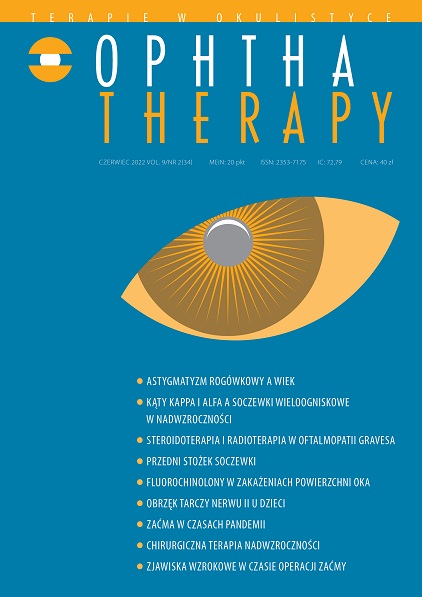Patient with cataract – observations after 2 years of the pandemic and future prospects Review article
Main Article Content
Abstract
Cataract is a disease in which the natural lens becomes completely or partially cloudy. During the pandemic, there was a significant decrease in the number of cataract surgeries performed compared to previous years, due to fear of the disease and the safety of the procedures performed. Cataract surgery should be performed in patients whose visual acuity deterioration has an impact on the performance of life or work activities. Due to the pandemic, some patients report to a more advanced stage of cataract, which leads to a reduction in their quality of life. Such surgery can be associated with a higher risk of surgical complications and longer recovery time. The development of new intraocular lens technologies, increased life expectancy, as well as changing lifestyles and increased activity of the elderly contribute to the increasing choice of premium intraocular lenses by patients. These lenses enable patients to achieve satisfactory uncorrected visual acuity not only for distance, but also for near and intermediate distances.
Downloads
Article Details

This work is licensed under a Creative Commons Attribution-NonCommercial-NoDerivatives 4.0 International License.
Copyright: © Medical Education sp. z o.o. License allowing third parties to copy and redistribute the material in any medium or format and to remix, transform, and build upon the material, provided the original work is properly cited and states its license.
Address reprint requests to: Medical Education, Marcin Kuźma (marcin.kuzma@mededu.pl)
References
2. Wytyczne SCOP_zaćma_aktualizacja.09.2021.pdf (access: 10.04.2022).
3. Załącznik do wytycznych operacyjnego leczenia zaćmy u pacjentów z astygmatyzmem rogówkowym (access: 10.04.2022).
4. Kanclerz P, Toto F, Grzybowski A et al. Extended Depth-of-Field Intraocular Lenses: An Update. Asia Pac J Ophthalmol (Phila). 2020; 9(3): 194-202. http://doi.org/10.1097/APO.0000000000000296.
5. Leyland M, Pringle E. Multifocal versus monofocal intraocular lenses after cataract extraction. Cochrane Database Syst Rev. 2006; 4. http://doi.org/10.1002/14651858.CD003169.pub2.
6. Shah S, Peris-Martinez C, Reinhard T et al. Visual Outcomes After Cataract Surgery: multifocal Versus Monofocal Intraocular Lenses. J Refract Surg. 2015; 31(10): 658-66. http://doi.org/10.3928/1081597X-20150611-01.
7. Greenstein S, Pineda R. The Quest for Spectacle Independence: A Comparison of Multifocal Intraocular Lens Implants and Pseudophakic Monovision for Patients with Presbyopia. Semin Ophthalmol. 2017; 32(1): 111-5. http://doi.org/10.1080/08820538.2016.128400.
8. Yamauchi T, Tabuchi H, Takase K et al. Comparison of Visual Performance of Multifocal Intraocular Lenses with Same Material Monofocal Intraocular Lenses. PLoS One. 2013; 8(6): e68236. http://doi.org/10.1371/journal.pone.0068236.
9. Kim CY, Chung SH, Kim TI et al. Comparison of Higher-Order Aberration and Contrast Sensitivity in Monofocal and Multifocal Intraocular Lenses. Yonsei Med J. 2007; 48(4): 27-633. http://doi.org/10.3349/ymj.2007.48.4.627.
10. Hawker MJ, Madge SN, Baddeley PA et al. Refractive expectations of patients having cataract surgery. J Cataract Refract Surg. 2005; 31(10): 1970-5. http://doi.org/10.1016/j.jcrs.2005.03.065.
11. Alió JL, Plaza-Puche AB, Fernandez-Buenaga R et al. Multifocal Intraocular Lenses: An Overview on the Technology, Indications, Outcomes, Complications and their Management. Survey of Ophthalmol. [In Review Process].
12. Alió JL, Pikkel J. Multifocal intraocular lenses: The art and the practice. Essentials in Ophthalmology. Switzerland: Springer International Publishing; 2014.
13. Kohnen T. First implantation of a diffractive quadrafocal (trifocal) intraocular lens. J Cataract Refract Surg. 2015; 41: 2330-2.
14. Kohnen T, Herzog M, Hemkeppler E et al. Visual performance of a quadrifocal (trifocal) intraocular lens following removal of the crystalline lens. Am J Ophthalmol. 2017; 184: 52-62.
15. RayOne Trifocal (access: 10.04.2022).
16. Sulcoflex Trifocal (access: 10.04.2022).
17. Maurino V, Allan BD, Rubin GS et al. Moorfields IOL Study Group. Quality of vision after bilateral multifocal intraocular lens implantation: A randomized trial – AT LISA 809M versus AcrySof ReSTOR SN6AD1. Ophthalmology. 2015; 122: 700-10.
18. Denoyer A, Le Lez ML, Majzoub S et al. Quality of vision after cataract surgery after Tecnis Z9000 intraocular lens implantation: Effect of contrast sensitivity and wavefront aberration improvements on the quality of daily vision. J Cataract Refract Surg. 2007; 33: 210-6.
19. Savini G, Balducci N, Carbonara C et al. Functional assessment of a new extended depth-of-focus intraocular lens. Eye (Lond). 2019; 33: 404-10.
20. Savini G, Schiano-Lomoriello D, Balducci N et al. Visual performance of a new extended depth-of-focus intraocular lens compared to a distance-dominant diffractive multifocal intraocular lens. J Refract Surg. 2018; 34: 228-35.
21. Kohnen T, Suryakumar R. Extended depth-of-focus technology in intraocular lenses. J Cataract Refract Surg. 2020; 46(2): 298-304. http://doi.org/10.1097/j.jcrs.0000000000000109.
22. Alcon Vision LLC. Acrysof IQ Vivity Extended Vision IOL Product Information. 2019. (access: 11.04.2022).
23. RayOne EMV. Monovision. Enhanced* (access: 11.04.2022).
24. Alio JL, Plaza-Puche AB, Férnandez-Buenaga R et al. Multifocal intraocular lenses: An overview. Surv Ophthalmol. 2017; 62: 611-34.
25. Mester U, Vaterrodt T, Goes F et al. Impact of personality characteristics on patient satisfaction after multifocal intraocular lens implantation: Results from the “happy patient study”. J Refract Surg. 2014; 30: 674-8.
26. Mester U, Vaterrodt T, Goes F et al. Impact of personality characteristics on patient satisfaction after multifocal intraocular lens implantation: results from the “happy patient study”. J Refract Surg. 2014; 30: 674-8.
27. Mamalis N, Brubaker J, Davis D et al. Complications of foldable intraocular lenses requiring explantation or secondary intervention – 2007 survey update. J Cataract Refract Surg. 2008; 34: 1584-91.
28. Kamiya K, Hayashi K, Shimizu K et al. Multifocal intraocular lens explantation: A case series of 50 eyes. Am J Ophthalmol. 2014; 158: 215-20.e1.
29. de Vries NE, Webers CA, Touwslager WR et al. Dissatisfaction after implantation of multifocal intraocular lenses. J Cataract Refract Surg. 2011; 37: 859-65.
30. Savini G, Hoffer KJ, Lombardo M et al. Influence of the effective lens position, as predicted by axial length and keratometry, on the near add power of multifocal intraocular lenses. J Cataract Refract Surg. 2016; 42: 44-9.
31. Muzyka-Woźniak M. Soczewki typu premium – dla kogo są przeznaczone i czy są skuteczne? Okulistyka po Dyplomie. 2020; 4: 18-26

